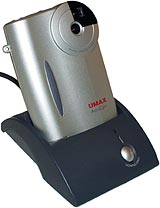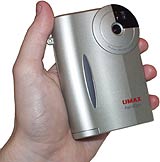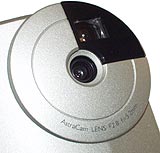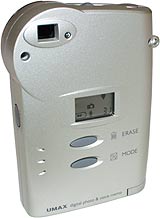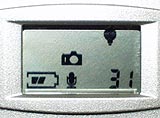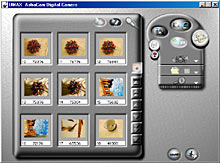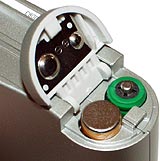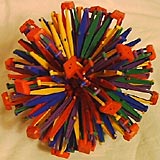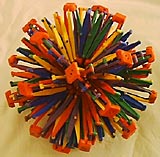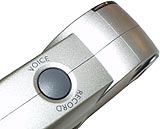
UMAX AstraCam
Review date: 4 July 2000.Last modified 03-Dec-2011.
Digital still cameras are too expensive. This is not a big secret.
For the price of a mid-range consumer digicam, you can get yourself a pile of very serious film-photography gear. If you don't need immediate results and/or privacy, there's a lot to be said for scanning the prints you need on the PC, or finding a processing place that'll put your film pictures on Photo CD. You'll have to take rather a lot of pictures before film ends up more expensive than digital.
But many digicam purchasers still find themselves surprised by just how expensive a digital camera turns out to be. Basic models start from around $AU500, and nicer consumer units are still over $AU1000. But then you discover your shiny new camera comes with a miserable little memory card that can only hold half a dozen full-resolution images.
And there's no AC plugpack. And there's no way to quickly get images into a computer without a separate card reader - serial interfaces are fast, compared with having film developed, but slow compared with just about anything else.
And there often aren't even rechargeable batteries, which are pretty much essential for digicams, whose high current draw means they rapidly suck the life out of alkaline cells, which can't handle the high load.
Bang goes another couple of hundred bucks on a nice big memory card, the thick end of a hundred on an overpriced name-brand AC adaptor, another more-than-a-hundred for a card reader for your PC, and $AU75 or so for a couple of sets of batteries and a charger.
Now, to be fair, it's often not quite that bad any more. Some digicam manufacturers now sell cameras whose list price is genuinely quite close to the "drive away" figure. The low-cost cameras are often still replete with hidden costs, but the better models generally come with most of what you need already in the box.
A lot of current cameras have USB connectivity, so people with appropriately equipped computers - recent PCs running Windows 98 or 2000, and recent Macintoshes - don't need to spend extra for a card reader. A fair few cameras come with AC plugpacks. Some even have batteries included. Most cameras still come with a crummy little memory card, but you can't have everything.
Or can you?
What a lot of people want from a digital camera isn't, necessarily, 35mm film quality. It isn't capacity for a thousand images, it isn't hyper-macro-focus or filter mounting threads or a high-quality preview screen or, indeed, any of the other selling points of expensive digicams.
What a lot of people want is a small, simple, cheap image acquisition device, with happy-snap image quality, about a reel-of-film worth of image storage, and easy-to-use software. They want something like a Polaroid instant camera, but digital.
And if it's cheap enough that you couldn't buy a professional auto-everything 35mm with three lenses and a hundred rolls of film for the same money, well, that's a bonus too.
If this is the kind of digicam you've been trying to find, then have a look at the UMAX AstraCam. It's less than $AU280 including GST (US list price $US199), it's got 640 by 480 image resolution, it's got on-board storage for up to 46 images, it's got a USB-connected docking cradle, and there's nothing more to buy.
Batteries are included, the docking cradle charges them when the camera's sitting in it, and the AstraCam can even record voice notes along with your pictures. Activate that mode and the image capacity drops to 31 exposures, though.
Since USB is the only way this camera can move its data to a computer, and since its software only works with Windows, you're out of luck if you've got a Macintosh, or if you're running a non-USB-aware operating system. Actually, you're out of luck if you're running anything but Windows 98, since that's all the UMAX software supports.
Lack of USB ports, by itself, isn't a stopper; you can get USB root hub cards for $AU65 or so.
What you get
Digital cameras don't come a lot simpler than this, but the AstraCam package is nonetheless quite complete. There's a multilingual manual - with different languages in different sections, not squished together on every page - and three software CDs, and the camera, cradle, power supply and batteries.
The AstraCam's got a glass lens, at least, but it's "focus-free". What this means is that the lens is fixed focus - it's calibrated to give reasonably sharp results at any point in its twenty-inch-to-infinity focus range, but it's only really sharp when the subject's actually at the lens' real focal distance.
Then again, the lens has a small aperture and thus good depth of field (the range over which images are sharp), and the camera's low resolution means the fuzziness of close-up and long-range shots is hard to see.
The AstraCam lens is a "50mm equivalent" - it's got the same field of view as a 50mm lens on a 35mm film camera.
The focal length number is the distance from the image sensor (or film, in the case of conventional cameras) that a pinhole would have to be to cast an image of the world upon the image sensor that's the same size as the image cast by the lens. Smaller image sensors make for smaller focal lengths; that "50mm" lens is actually a 5.2mm, because of the small image sensor in the AstraCam.
50mm equivalent isn't very wide angle; the AstraCam isn't quite the camera you want if you're indoors and want to take a picture of 25 people at once. But it's a good compromise for a camera with no zoom. More distant subjects are less likely to be hopelessly far away.
The AstraCam back panel is simple, too. The Mode button changes the white balance setting, and does nothing else; the Erase button kills pictures from the most recently taken backwards; hold it down long enough and you can erase the whole memory without having to put the camera in the cradle.
There's no image preview screen - not for this price, pal - but you do get a simple LCD status panel that tells you what settings you've selected, and how many pictures you can take before the memory will be full. Pictures generally work out at about 70 kilobytes in size, and they're stored in JFIF (JPG) format.
Setting up
Like a few other USB gadgets, the AstraCam requires you to install its driver software before you plug it in.
The main driver is a TWAIN jobbie, so you can use it with any half-decent imaging package, and various other apps as well. There's basic image adjustment in the TWAIN driver, and you can use it to tell the camera to take a picture as it sits in the cradle, too.
TWAIN drivers aren't like most other driver software, which is invisible - it's just a software doohickey that sits between your operating system and some hardware and lets programs access that hardware by using standardised calls, without having to know what language the hardware itself wants to speak.
TWAIN drivers are different. They're applications in their own right. You run the driver, by telling some other application to acquire an image from the currently selected TWAIN device, and the driver runs and gives you an interface that lets you control the device in question.
The "Mega Pixel" feature of the AstraCam driver turns the resolution up to an imposing 1280 by 960. It doesn't make the pictures look any better, though - it just interpolates in extra pixels, making a bigger, fuzzier version of the same thing. Various cheap scanners use the same trick to get a "19200 by 19200 dot per inch" maximum resolution. Don't be fooled. It's not real.
Out of the box, the two little 600 milliamp-hour (mAh) AAA nickel metal hydride (NiMH) rechargeable cells will be flat as a tack; you'll need to leave the camera in its cradle for a while to charge them. The full from-flat charge time is quoted as 2.6 hours, which seems about right and indicates a charging system that's not too likely to boil the cells to death.
If you're wondering why a charger could be expected to massacre cells, it's because NiMH charging is tricky. The cells don't have a clear voltage peak that indicates when they're full, so good chargers check the cell temperature (they get warm as they charge, but get hotter faster when they're full) as well as the voltage.
I don't know whether the AstraCam charger works this way - it could be a simple constant-voltage system with a cut-out when the cell voltage reaches a particular value. I hope it works this way, because a 2.6 hour charge time for little cells like these means about a 300 milliamp average charge current, which is on the high side for teeny-cells, and every time you put the camera in its cradle - even if all you did was take it out, look at it and put it back - the light on the front goes orange, indicating a charge, for quite a while. If it's 300 milliamps every time that happens, the cells won't be long for this world.
In the event that your NiMH cells do get toasted, you can always buy more, of course. They only cost about $AU4 each.
If you're caught short, the AstraCam lets you use ordinary AAA alkaline cells as well. You mustn't leave them in the camera when you put it into the cradle, though; the cradle tries to charge whatever batteries you leave in the camera, which is not a good idea for non-rechargeable cells. Fortunately, the camera doesn't need to have batteries in it to work in its cradle.
Software
The AstraCam TWAIN driver, unusually, lets you save images to files directly, as well as just squirting them into whatever program called the driver.
The saver's a tad annoying - you can't save a batch of files in one go, and it seems rather whimsical about remembering where you told it to save files to last time - but it works adequately well. The direct save is an essential feature, if you want to avoid the image quality loss caused by TWAIN-ing the image data to a graphics program and then JPG compressing it again to save it.
You can save TWAIN-imported pictures as some other format that isn't lossy-compressed, of course, and lose no quality. But that gives you the worst of both worlds - the slightly blocky image quality of JPG, and the ten-times-bigger file size of a format like compressed TIFF.
Along with the TWAIN driver you get PhotoCabinet, yet another entrant in the hotly contested Picture Cataloguing and Thumbnailing Application market. Well, I presume it's hotly contested; every cheap digital camera, webcam or scanner seems to come with a different application that does much the same thing, so I suppose someone must be demanding them.
PhotoCabinet is the application that runs when you press the "DOWNLOAD" button on the front of the AstraCam cradle. This gives you an automatic dump of all of the images in the camera.
PhotoCabinet can save files in various formats, including the "Presto! Wrapper" format that includes a viewer program with the picture. Or pictures - you can save a string of images in the one executable. Run it, and you can easily page through them or jump to a particular one, from a side-bar thumbnail display.
The wrapper only adds about 150 kilobytes to the combined sizes of the images - a lot, for only a couple of pictures, but not much if you're bundling together 30 shots from the party last night, or whatever. It's a nice idea.
Apart from this, there's nothing at all unusual about PhotoCabinet. It does the job.
There's also VistaShuttle, a straightforward home-user package that lets you incorporate your pictures in printable cards, e-mailable e-cards, calendars, posters and screen savers, or just make a Windows wallpaper out of a picture. VistaShuttle is meant to ship with scanners, so it talks about "scanning" images, but it works fine with anything that's got a TWAIN driver.
And, if this isn't enough, you also get a copy of Adobe PhotoDeluxe version 2.0. This isn't particularly new, but it works well enough. PhotoDeluxe is Adobe's cut-down and super-simple image manipulation package, which uses Photoshop filter technology but doesn't let you customise the various effects. For average-Joe image tweaking, PhotoDeluxe is excellent.
UMAX also provide a "Switcher" utility that makes the AstraCam work as an ordinary Video For Windows motion-video device - a webcam, essentially. There's no software included that takes advantage of this feature, but pretty much any Windows webcam software, like Microsoft NetMeeting, should work fine with the AstraCam in this mode.
Using it
Taking pictures with the AstraCam is about as simple as you'd expect. You half-press the shutter button to let the camera set its exposure; it beeps. You fully press the shutter button and you get a longer beep; when that beep ends, the picture's actually been taken and the activity light next to the viewfinder starts blinking as the image is saved. It takes less than two seconds to save an image - an advantage of the camera's low resolution and small file sizes.
If you take your finger off the shutter button before the longer picture-taking beep is over, the camera won't take a shot. This is a bit weird at first, but easy enough to get used to.
The driver can import something like six thumbnail-views per second from the camera; even if you've taken the full 46 pictures, you'll have the full thumbnail list in about eight seconds. Importing images into a program is also pleasingly speedy - you can select as many as you like from the TWAIN driver interface and import them in a batch, and it takes little more than a second for each one.
Image framing is a bit more annoying.
Many cameras have viewfinders that show you a bit less than the lens sees, on the principle that it's better to include a bit more background than you expected than to chop off the tops of people's heads. The AstraCam, though, has the over-sized kind of viewfinder - the camera only photographs an area about seven-eighths as wide and high as the viewfinder shows. So about three-quarters of the viewfinder area is actually photographed. Glasses-wearers, with their eye further away from the viewfinder, will see a more accurately framed scene.
Cameras that work this way really should have an inner frame marked on the viewfinder that shows you what you're really going to get. The AstraCam doesn't, so you just have to try to leave an appropriate border around your subject.
The coaxial viewfinder, which doesn't show you exactly what the lens sees, also contributes to framing errors, for close-ups.
The middle of the viewfinder is less than 15mm diagonally from the middle of the lens, so as coaxial-finder cameras go, this isn't too bad a one. Only for quite close shots does it make a difference. But, again, there's no frame in the viewfinder to give you a hint as to what you might really be photographing, and with no preview screen there's no way to tell if you've messed up except by popping the camera into its cradle.
Inaccurate framing can be particularly annoying with low resolution cameras like this one. If a whiz-bang 1600 by 1200 digicam does the same thing, so you have to leave a safety margin around your subjects, it's no big deal. You can crop out the middle of the image and still end up with enough resolution to print a nice-looking photo-size picture.
When you've only got 640 by 480, though, you need all the pixels you can get to be used for the subject of the picture, and as few as possible to be used for the margin. Happy snappers won't care much, but if you're trying to do more serious digital photography on the cheap - you're a shoestring-budget Web designer, say - then you'll need to practice to get the best out of an AstraCam.
There are canned white-balance settings for sunlit, overcast, incandescent and fluorescent-lit subjects. They work pretty well, although indoor shots are still likely to be yellowish. Outdoor shots using the appropriate setting have quite acceptable colour balance.
Image quality
The AstraCam takes surprisingly good pictures, considering its price.
Cheap plasticky digital cameras have, traditionally, been reliable producers of output that makes shots from the average passport-photo booth look like... well, like photos you could actually legally use on a passport.
The AstraCam's clearly not up there with "proper" digicams, but neither does it produce the nasty, grainy, washed-out, blurry, distorted crud that you'll get from the still-capture function of cheap webcams - which are about all you'll be able to find for less than the price of an AstraCam.
In daylight - overcast daylight, in this case - the AstraCam performs well, with reasonable focus (its shortcomings are covered up by the low resolution), not-too-awful image distortion, and good colour rendition.
The JPG compression's a bit strong, but I've seen worse. Sony's floppy-disk-based Mavica cameras, for instance, compress a lot more than the AstraCam, but a lot of people seem happy enough with them.
High-contrast edges, like tree branches against the sky, will be fuzzed out. And the unchangeable full-frame exposure metering means a light subject against a dark background - a white flower among foliage, say - will be overexposed. Similarly, dark subjects against light backgrounds will probably be underexposed.
But much more expensive digicams have these same problems, and they're really not too severe in the AstraCam.
Where I expected the AstraCam to, not to put too fine a point on it, suck, was for indoor photography. Indoor lighting is commonly a couple of orders of magnitude dimmer than full sunlight, and that's a big difference.
Digital cameras all have fairly low sensitivity - they need lots of light, or long exposure times, to get a good picture. Fixed focus digicams with teeny little lens apertures, like the AstraCam, are worse than the average.
The AstraCam scores an ISO 125 sensitivity rating, which is not too bad by digicam standards - many still score only 100 - but is still nothing to write home about.
More expensive digicams deal with the sensitivity problem by using a flash, but the AstraCam doesn't have one. So I expected the order of the day to be 'orrible graininess, very dim images, crummy colour rendition, et cetera.
I was completely wrong.
Here's the AstraCam's opinion of a brightly coloured Hoberman sphere, in a night-time room lit by a single hundred watt bulb. Which was behind me when I took the shot - I was shading the subject.
So the picture should have stunk.
It didn't.
This pic looks much the same, but it was taken with quite a bit more light - a 500-watt halogen flood pointing at the ceiling. Click the image for the full-resolution version and you might notice it's a little sharper, because the camera could use a shorter exposure for this brighter scene. But the colour rendition and image clarity are about the same.
It's not really fair to just look at the raw output from a digicam, of course; anyone with a cursory acquaintance with image manipulation software can greatly enhance the pictures in moments.
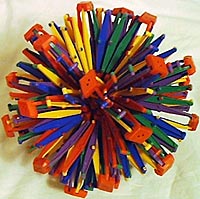
Here's the low-light image after a simple Auto Levels, slight gamma tweak and Unsharp Mask in Photoshop. It took me about five seconds to do.
I then decided to be really mean to the AstraCam, and took a picture of myself by the light of a white screen on my monitor.

I've never been able to figure out why people won't sit next to me on buses.
The attractiveness of the subject aside, this is a good picture. Quite sharp, even though it's inside the camera's stated 20 inch minimum focus distance. Not grainy. Natural skin tone (using the "fluorescent" white balance setting).
Now, a Caucasian face a foot away from a white-screen 19 inch monitor is hardly a worst-case-scenario for low light performance. But the AstraCam handled it much more elegantly than I expected. I was impressed.
Audio
Recording voice notes to go with pictures is easy enough.
There's a separate "VOICE RECORD" button on the side of the camera; you just press and hold it after taking a picture, and talk into the microphone holes on the camera back. You can record up to 20 seconds of audio with each picture, and you can play the sound back from the TWAIN driver, or in PhotoCabinet.
Unfortunately, the microphone's not very sensitive. It picks up the clicks and scrapes of your hand holding the camera just fine, but you need to be close to the camera and talk loudly to get a clear recording. Ordinary speech from a foot away will be scratchy and nasty, though it's still comprehensible.
You can only switch between recording and no-recording modes when the camera memory's empty.
Overall
The AstraCam isn't alone in the dirt-cheap-digital department. Fuji's MX-1200 digicam, for instance, doesn't cost much more than the AstraCam. You can find it in the USA for less than $US240. It's got genuine 1280 by 960 image resolution, a flash, selectable resolution and compression, and plenty of other Proper Camera features that put it ahead of the AstraCam.
But the MX-1200 stores its images on memory cards - SmartMedia cards, in this case. And, in the great tradition of cheap digicams, it comes with... a two megabyte card. Good for two top quality images. So there goes $AU150 or more for a good-sized card.
And the MX-1200's only got serial connectivity; if you want to move pictures fast, you need to buy a card reader. $AU120.
And it doesn't come with rechargeable batteries, or a charger, or an AC plugpack. Poof goes another $AU100, at least.
So, when you get right down to it, a far superior camera that seems to cost only $AU200 or so more than the AstraCam actually ends up costing a quite comfortable $550 more. Sure, you get a lot more camera for that money - although there's no sound recording or webcam functionality - but that's not the point.
If you're after a works-straight-out-of-the-box, low-cost, dead-easy-to-use digicam with passable image quality, the AstraCam is what you need. There are, I think, better value cameras out there. There are certainly cameras that take far better pictures. But they're not nearly this cheap.
Recommended.
Pros: |
Cons: |
|
|
